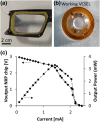A laser emitting contact lens for eye tracking
- PMID: 32908167
- PMCID: PMC7481179
- DOI: 10.1038/s41598-020-71233-1
A laser emitting contact lens for eye tracking
Abstract
In this paper, we present the first realisation and experimentation of a new eye tracking system using an infrared (iR) laser pointer embedded into a wireless smart contact lens. We denote this contact lens prototype as the cyclops lens, in reference to the famous hero of the X-Men comics. The full eye tracker device combines the smart contact lens and its eyewear, which provides a primary source of energy and the beam detection system. We detail the assembling and encapsulation process of the main functionalities into the contact lens and present how a gaze tracking system is achieved, compared to existing conventional eye-tracking ones. Finally, we discuss future technical improvements.
Conflict of interest statement
The authors declare no competing interests.
Figures






References
-
- Kress, B. Digital optical elements and technologies: Applications to AR/VR/MR. in Proceeding SPIE 11062, Digital Optical Technologies, 11062 22 (2019).
-
- Shtukater, A. Smart Contact Lens with Orientation Sensor, US Patent 20170371184A1. (2019).
-
- Morimoto MR, Mimica M. Eye gaze tracking techniques (EGTs) for interactive applications. Comput. Vis. Image Underst. 2005;98:4–24. doi: 10.1016/j.cviu.2004.07.010. - DOI
-
- Meroni, A., Pradhapan, P. & van der Heijden, P. System, Device and Method for Eye Activity Monitoring, U.S. Patent Application No. 16/387,950 (2019).
-
- Whitmire, E., et al. EyeContact: Scleral coil eye tracking for virtual reality. in Proceedings of the 2016 ACM International Symposium on Wearable Computers, 184–191 (2016).
MeSH terms
LinkOut - more resources
Full Text Sources
Other Literature Sources

